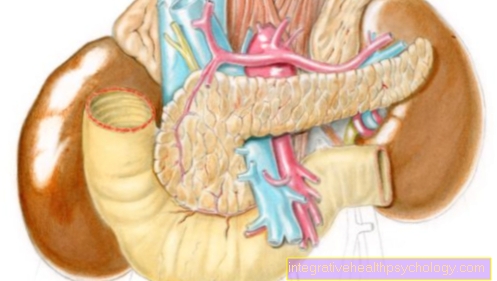Viruses
definition
Viruses (singular: virus) are the smallest, infectious particles and also parasites, i.e. living beings that cannot reproduce independently without a host organism. On average, a virus particle is between 20 and 400 nm in size, which is many times smaller than human cells, bacteria or fungi.

Build up of viruses
Viruses are not very complex in structure. The most important component of viruses is their genetic material. In the case of viruses, this can either be in the form of DNA (Deoxyribonucleic acid) or RNA (Ribonucleic acid) are available. This feature can also be used to differentiate between DNA and RNA viruses (there are also so-called retroviruses, which are a subgroup of RNA viruses).
The genetic material can either be in the form of a ring or thread inside viruses. If the virus has not yet established itself in a cell, it is called Virion designated. In almost all cases, the genetic material is surrounded by a capsid, which serves to protect the genetic material. This capsid is a structure made up of many identical subunits (Capsomeres) that consist of proteins. As a result, the capsid is often referred to as the protein shell, together with the DNA or RNA one speaks of Nucleocapsid.
In addition, some viruses are surrounded by another envelope, the virus envelope, which is made up of a lipid bilayer in which proteins and glycoproteins are partially embedded. The glycoproteins protrude spike-shaped from the shell, which is why they are also known as "spikesSuch viruses are called enveloped. If the virus envelope is missing, it is called an unenveloped virus.
In addition, some viruses have other components, but never a cytoplasm with cell organelles as in human, animal or plant cells, which would enable them to metabolize themselves. Since both mitochondria and ribosomes are missing, viruses are not capable of protein biosynthesis on their own and cannot produce their own energy. It has to nestle in a so-called host cell, i.e. a cell of a person, for example, that has the necessary material. There the virus is able to manipulate the cell metabolism in such a way that it adapts to the needs of the virus and, instead of its own proteins, produces proteins that the viruses need to survive.
Illustration of a virus

Viruses (singular virus)
- Virus envelope
Lipid bilayer - Capsule
Protein shell
Capsomeres - nucleic acid
(RNA or DNA viruses)
Ribonucleic acid
Deoxyribonucleic acid - Membrane proteins
Lipid proteins (spikes) - Capsomer (subunit)
A - unenveloped virus
(Nucleic capsid)
B - enveloped virus
(Virion)
Structure from:
Genetic material - Nucleic acids
Proteins - Proteins
Lipids (sometimes)
You can find an overview of all Dr-Gumpert images at: medical illustrations
Virus multiplication mechanism
In addition, it is possible for the virus to multiply by introducing its DNA or RNA into the host cell (replicate). The first step is always for the virus to attach to the host cell. The genetic material is then introduced into the cell. There the cover (s) are then removed (uncoating), whereupon the nucleic acid can get into the cell nucleus. There it practically takes over the control and first of all ensures that the genetic material is reproduced and proteins are produced.
From these individual components, new virus particles can finally form again. There are two different ways in which the virus can complete reproduction.
1. Lytic cycle: here the cell membrane is completely dissolved, i.e. the cell is destroyed and the new viruses are released.
2. Lysogenic cycle: the cell does not die, but the viruses are only smuggled out of it (budding) by taking part of the host cell's cell membrane with them in order to form a shell.
How many viruses emerge from a single host cell in such a process differs from virus to virus. While a cell infected with the herpes virus produces on average only 50 to 100 new viruses, for example, a cell infected with the poliovirus releases more than 1000 new viruses.
Types of viruses
Almost all viruses are host-specific, which means that a particular virus usually only affects one particular host organism. Depending on which organism it is, a distinction is made
- (Bacterial) phages = viruses that only attack bacteria
- Plant / phytoviruses that only affect plants
- Animal viruses / animal viruses that only affect animals and
- Human / human viruses that attack us humans.
An incredible number of these human viruses exist, which is why only the most important ones can be mentioned here. Most viruses lead to a specific disease in humans.
Known DNA viruses
The most important human pathogens belong to the DNA viruses:
1. The herpes viruses, in which one again distinguishes a large number of subgroups. The herpes viruses include the human herpes virus 1 and 2, which are responsible for the well-known herpes, which is noticeable in the form of blisters, pain and / or itching and is usually found on the lips (Herpes labialis, especially HHV 1) or in the genital area (Genital herpes, especially HHV 2) manifested.
The HHV 6 is responsible for the so-called 3-day fever.
- The Epstein-Barr virus (EBV), the Pfeiffer glandular fever (also: Mononucleosis or "Kissing Disease") is also one of the herpes viruses
- Varicella zoster virus (VZV), which leads to chickenpox in the case of an initial infection and to shingles (herpes zoster) in the case of a secondary infection.
- Cytomegalovirus (CMV) which is particularly feared by pregnant women, as it can be life-threatening for unborn children.
A herpes virus that is rarely encountered is HHV 8, as it only really leads to an infection in people with a weak immune system (for example people infected with HIV), which causes a certain type of cancer, Kaposi's sarcoma.
2. The group of smallpox viruses includes, on the one hand, the triggers of harmless warts and, on the other hand, those viruses that cause dangerous smallpox.
3. The hepatitis B virus causes liver inflammation.
4. Of human papillomaviruses (HPV) There are various different types that also lead to different clinical pictures. While most (e.g. types 6 and 11) are relatively harmless, some (e.g. types 16 and 18) can develop cancer of the cervix (Cervical cancer) cause.
5. Adenoviruses are often the cause of diarrhea or colds with a runny nose.
Known RNA viruses
Of particular importance in the case of RNA viruses for humans are:
- The group of flaviviruses includes the hepatitis C virus, which, just like the hepatitis B virus, can cause inflammation of the liver, but which is much more chronic than HBV, and the viruses that cause yellow and dengue fever are responsible.
- Coronaviruses are often the cause of gastrointestinal flu (gastroenteritis) or a special, serious type of pneumonia (SARS).
- The most important representative of the retroviruses is the human immunodeficiency virus HIV (type 1 and 2), which is responsible for AIDS.
- Orthomyxoviruses include the influenza viruses that lead to flu.
- The triggers of mumps and measles belong to the paramyxovirus family.
- Filoviruses, which include the Marburg virus and the Ebola virus, the infection of which is often fatal. Read more about Ebola.
Therapy of viral diseases
Viruses can not only cause disease, however. Much research is currently being carried out into using viruses as a therapy. For example, certain viruses should be able to be used against certain forms of cancer or serve as vaccines.
You may also be interested in this topic: Viral infection
It is more difficult to cure an infection caused by viruses than, for example, bacteria-related diseases, since viruses are not independent cells but are always found in human cells. That is why killing a virus also means killing a body cell.
In order to fight viruses, so-called antivirals are used. These are drugs that prevent or at least limit the multiplication of viruses.
The main targets of antiviral drugs are:
- Penetration of the virus into the cell
- Influencing the cell metabolism to the detriment of the host cell and
- The viruses are released at the end of their replication cycle.
However, these agents are often associated with sometimes serious side effects.
Read more about here Antiviral drugs.
What is the HP virus?
The human papilloma virus - HPV for short - is the main cause of the known skin warts and can increase the risk of certain types of tumors developing. In the group of HP viruses, over 150 different types can now be found, which, roughly speaking, differ in the severity of the warts they cause.
Please also read the article on this: Human papilloma virus
On the one hand, there are types that cause normal skin warts that form on the hands, feet or, for example, the armpits. Although they are not very aesthetic, they are harmless and usually disappear on their own.
Second, there are types that cause harmless genital warts called condylomas. Transmission usually occurs here during sexual intercourse. These warts are also unaesthetic, but not tumorous skin changes.
Thirdly, there are types that cause skin changes in the genital area, which have a cancer tendency.
A well-known example of this is cervical cancer, which also explains why you can “vaccinate” yourself against a type of cancer.
The viruses are transmitted very easily, as they can easily survive in the environment for several days without dying. The virus then penetrates through microscopic skin lesions and attacks human skin cells, whereupon the warts develop.
Read more about this: Vaccination against cervical cancer, symptoms of cervical cancer
What is the Ebola Virus?
The Ebola virus is one of the so far little researched and dangerous viruses whose infection is associated with a high death rate.
Please also read the article on this: What is the Ebola Virus?
The virus probably originated in a species of flying fox that is native to a cave in West Africa. It was from here that it was transmitted to the person who spread the virus.
The subsequent illness begins with unspecific symptoms such as conjunctivitis and only develops a characteristic rise and fall in body temperature after about a week. The result is rash-like reddening of the skin and ultimately an infection of the body's own immune cells and massive blood loss as the body's own blood vessels lose their tightness.
Only the symptoms can currently be treated; systematic therapy to combat the virus in the form of drugs or vaccinations are not yet available.
What is the RS virus?
The respiratory syncytical virus (RSV for short) is a cause of respiratory diseases, especially in childhood. The virus usually leads to epidemic-like outbreaks worldwide in late autumn. It mainly affects the upper respiratory tract, but in particularly severe cases it can also reach the lungs and lead to lung or pleural inflammation. In the vast majority of cases, however, only the throat and bronchi are affected. Sometimes, however, it also leads to an otitis media.
The viruses cause minor cell death of the tracheal cells and in the worst case can clog them with degradation products or the resulting mucus, which leads to shortness of breath.
The aforementioned respiratory diseases mainly occur in young children up to the age of three. After this point in time, almost 100% of the antibodies against the virus have formed, so that the infections only appear as a mild cough or slight irritation of the throat.
Treatment is currently still symptomatic. So one tries to loosen the mucus in the bronchi and to cure any inflammation that may arise.
The removal of the virus, on the other hand, is left to the body's own defenses. In very rare cases and if the disease progresses badly, a so-called antiviral can be used.
You can find everything on this topic in our article: The RS virus
What is HIV
The human immunodeficiency virus, or HIV for short, actually consists of two types: HIV 1 and HIV 2.
These, in turn, can be divided into different subspecies depending on the location of the outbreak. In all likelihood, HIV stems from a similar type of virus. This affects chimpanzees and is called SIV, Simian Immunodeficiency Virus. The transmission and conversion of the virus probably took place around 1900 in West Africa and spread from here into the world.
There are currently around 37 million sick people worldwide and around 1 million fatalities every year.
The transmission of the HI virus can occur either through blood, through sexual intercourse or from the mother to the unborn child. The likelihood of being infected depends on the amount of virus transmitted.
After the transmission, the first thing you notice is cold symptoms. The full expression of the viral infection, the so-called AIDS syndrome, only occurs after a few months or years. There are permanent symptoms of infection, the likelihood of developing a tumor is drastically increased and structures of the nervous system are also attacked.
Fortunately, the viral load can be well contained and the manifestation of the disease reduced if patients see a doctor immediately after exposure to HIV-infected body materials.
The difficulty in treating HIV or the reason why there is no effective vaccination against HIV is that the virus is extremely changeable and is changed within a reproduction cycle in such a way that it is no longer recognized by the human immune system.
You can also read about this: Symptoms of HIV, Symptoms of AIDS
What is the rotavirus?
Rotaviruses cause diarrhea. It is estimated that up to 150 million people are infected with rotavirus every year. Many of the infections are barely noticeable because you come into contact with rotaviruses over the course of your life and thus maintain an almost permanent immune protection.
The disease is usually only dangerous for small children, elderly patients and in countries where there is not enough clean water.
The viruses attack the small intestine and, through cell death, reduce the ability to absorb water, which is why patients should drink more water to counteract this lack of fluids.
The diarrhea is usually not bloody and is often associated with vomiting. Fever develops better than ever, only elevated temperatures of up to approx. 38 degrees Celsius.
Read more about this: Home remedies to treat diarrhea, anti-vomiting medication
The viruses are usually transmitted through improperly cleaned hands after using the toilet. The next person affected then spreads the viruses, for example through food, into their mouth, from where they find their way into the small intestine, where they can become lodged and cause diarrhea.
The illness usually lasts a maximum of one week.
There is no vaccination, the affected person is given more fluids and their salt balance is checked.
Read more about this: Vaccination against the rotavirus
What is the norovirus?
In addition to the rotavirus, the norovirus is the main cause of viral vomiting and diarrhea diseases: the virus embeds itself in the early small intestine and causes the intestinal cells there to deteriorate.
As a result, the intestine can no longer absorb enough water from the stool and severe diarrhea occurs as a result. However, the disease is mainly characterized by severe vomiting and severe abdominal cramps.
The symptoms only last two to three days and then go away on their own. The disease mainly affects children shortly before school age.
The severe loss of fluid can make it dangerous for people who do not consume enough water to make up for the loss. In the specific case, it is small children and old people who, in the worst case, can "dry out".
The disease is treated purely symptomatically: people are given more fluids and attempts are made to maintain the patient's salt balance.
Read more about this: Gastrointestinal virus - causes and treatment, homeopathy for vomiting
What is the hepatitis virus?
Basically, one cannot speak of "the" hepatitis virus. At least five hepatitis viruses are currently known to research. From hepatitis A to hepatitis E, the viruses differ both in their clinical pictures and in their danger to humans. Even if there are several hundred thousand people with hepatitis in Germany, this virus is more of a problem in developing and emerging countries.
In Germany, those affected - provided they are undergoing medical treatment - can now be helped very well, so that the likelihood of dying from a hepatitis infection is very low.
- While hepatitis A only causes acute inflammation in almost 99% of cases, which subsides after about a week, the two most well-known types of hepatitis, hepatitis B and hepatitis C, are more dangerous for humans.
- Hepatitis B is a disease that affects around 400 million people worldwide and is vaccinated against. Transmission usually takes place through contaminated blood and the disease can lead to liver cirrhosis or in the worst case to liver cancer in an advanced stage.
- Hepatitis C affects around 170 million people worldwide and is now very treatable thanks to modern drugs. Here, too, infection usually occurs through infectious blood and the disease can lead to cirrhosis of the liver or, in the worst case, to liver cancer.
- Hepatitis D is a so-called superinfection. It occurs almost only in combination with a hepatitis B disease and can best be combated by a vaccination against hepatitis B, as the two forms are very similar in their surface properties.
- Like hepatitis A, hepatitis E mainly causes acute inflammation of the liver and only a very minor part of it becomes a chronic disease. A vaccination is not yet available, but the disease can be cured with medication.
Read more on this topic: Vaccination against hepatitis B, symptoms of hepatitis A





























